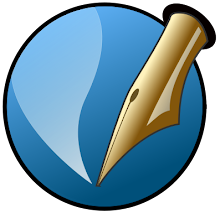Menulis dan menerbit buku kini menjadi cita-cita ku.. Semejak saya kunjungi website www.terbitsendiri.com saya terus berminat untuk menulis buku dan terbit buku sendiri. Saya terus mengambil tindakan dengan membeli buku yang dijual dalam website tersebut. Walaupun buku tersebut agak mahal, tetapi agak berbaloi membelinya.
Tetapi saya tiada kemahiran menulis buku. Lagipun kalau saya buat buku, ada ke pembelinya. Kalau saya ni penulis terkenal ianya tidak menjadi masalah, mesti buku yang ditulis mudah untuk dijual. Atau saya ni pensyarah atau penceramah kursus, boleh lah saya jual kepada pelajar dan peserta kursus. Tapi saya tiada semua itu. Semajak dari situ, saya terus berfikir, adakah saya perlu menulis buku sedangkan saya ni tiada pengalaman menulis dan tidak terkenal. Setelah berminggu-minggu berfikir, akhirnya saya dapat idea, Ya! menjadi penulis blog. Dengan menjadi penulis blog, saya dapat memahirkan diriku dalam bidang penulisan. Dengan menulis blog, mungkin orang akan lebih mengenali saya. Bila saya dah ada pengalaman menulis dan orang pun sudah kenal saya, masa tu bolehlah saya menulis dan menerbit buku sendiri. Saya berharap, saya dapat menulis buku dalam masa terdekat. Memang terbukti, ramai penulis blog kini telah menulis buku sediri, contoh terdekat ialah penulis blog www.saifulislam.com. Asalnya hanya penulis blog, kini penulis tersebut sudah dikenali oleh ramai orang dan juga telah menulis buku sendiri.
Untuk menulis dan menerbit buku sendiri, saya mestilah tahu menggunakan perisian desktop publishing seperti Adobe InDesign, QuarkXpress atau pun perisian open source Scribus. Saya telah mengkaji software-software tersebut, Adobe InDesign memang senang untuk digunakan, tetapi software memang agak mahal. Namun Adobe InDesign sangat berat untuk digunakan dalam laptop dan PC saya. Kemudian saya cuba menggunakan QuarkXpress, software ini agak terkenal jugak dikalangan penerbit-penerbit dan penulis-penulis buku. Tetapi ianya lebih mahal berbanding Adobe InDesign. QuarkXpress juga agak mudah digunakan. Saya boleh je nak menggunakan perisian tersebut dengan mencari crack untuk software tersebut. Tetapi saya tidak mahu menggunakan cara tersebut. Saya mementingkan keberkatan dalam menulis dan menebitkan buku. Oleh itu, saya mengambil keputusan untuk menggunakan perisian sumber terbuka, iaitu Scribus. Scribus memang pilihan terbaik. Selain ianya percuma, perisian ini memang sangat mudah untuk digunakan. Saya sudah cuba bermain-main perisian ini dengan membuat beberapa tutorial yang terdapat dalam internet. Memang menyeronokkan!.
Oleh itu, insyallah, dalam Mahir Linux saya akan banyak menulis tutorial mengenai Scribus. Bukannya kerana saya mahir menggunakan scribus, tetapi dengan cara menulis tutorial mengenai Scribus, kemahiran dan kecekapan saya menggunakan Scribus akan meningkat. Moga cita-cita saya untuk menulis dan menerbit buku sendiri tercapai suatu hari kelak. Amin.
Monday, August 24, 2009
Friday, August 21, 2009
Scribus 1.3.5.1 Released
 Scribus is an open-source program that brings award-winning professional page layout to Linux/UNIX, Mac OS X, OS/2 and Windows desktops with a combination of "press-ready" output and new approaches to page layout. Underneath the modern and user friendly interface, Scribus supports professional publishing features, such as CMYK color, separations, Spot Colors, ICC color management and versatile PDF creation.
Scribus is an open-source program that brings award-winning professional page layout to Linux/UNIX, Mac OS X, OS/2 and Windows desktops with a combination of "press-ready" output and new approaches to page layout. Underneath the modern and user friendly interface, Scribus supports professional publishing features, such as CMYK color, separations, Spot Colors, ICC color management and versatile PDF creation.After almost 2 years of intensive work, the Scribus Team is proud to announce the release of Scribus 1.3.5. This release is a major development version on the road to milestone 1.4, which will be based on 1.3.5.
Following many testing cycles, the Scribus Team considers this version to be fairly stable and ready for many real-world use cases. For example, the cover of the Official Scribus Manual has been created with a release candidate of 1.3.5. However, since there are still some rough edges, more cautious users may want to prefer to stick with the officially stable series 1.3.3.x, which will see its final bugfix release soon.
The Scribus Team will continue to implement new features and improvements in a new experimental branch. Once tested and confirmed as working flawlessly, they will be backported and become part of the 1.4 milestone.
In comparison to the latest developer release, Scribus 1.3.5 provides the following major changes and enhancements:
- 1.3.5 is based on Qt 4 (the minimum required to run 1.3.5 is Qt 4.5.0)
- A native OS X version, available as DMG file (Universal Binary)
- Improved menu integration with OS X
- Large parts of the canvas and text code have been rewritten
- A new frame type called Render Frames, which allows for rendering markup languages like LaTeX or POV-Ray inside Scribus
- Added import filters for the following vector formats: Adobe Illustrator, Xfig, WMF
- Added import filters for colour palettes, including allowing palette import from EPS/AI files
- Major improvements to the handling of solid colours, as well as new colour palettes
- Drag and drop improvements
- PDF 1.5 presentation effect support
- Optional embedding of PDF and EPS files
- Transform effects for items
- Path tools for shapes
- Added more additional default shapes, line patterns and arrowheads
- A new line editor for custom line styles
- A new Quick Start Guide in the Help Browser, as well as other major updates and enhancements to the online help
- Significant enhancements to existing features like the Scrapbook, the Image Manager or the Font Preview
Installation
Ubuntu Jaunty Jackalope (jaunty or 9.04):
deb http://debian.scribus.net/debian/ jaunty main non-freeOr
deb http://debian.tagancha.org/debian/ jaunty main non-free
Download Deb package for Jaunty at Getdeb.
Tuesday, August 18, 2009
Installing Software on Ubuntu - Part 3 (Synaptic Pakage Manager)
Sometime, not all software or packages listed in Add/Remove application. So you can use synaptic package manager.
1. Go to System -> Administration -> Synaptic Package Manager. Enter password and click OK.


2. Type software name on Quick search box and or you can click Search button for advanced search. Once you've found the software you want, left-click and choose Mark for Installation from pop-up menu.


3. Click Mark button for additional packages.
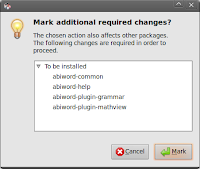
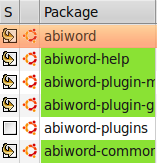
4. Click Apply button, and click apply again on Summary pop-pup window.

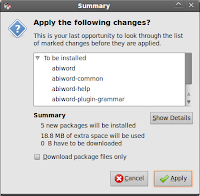
5. Wait for the package files to download and install. Once they've installed, click Close.

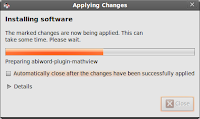
1. Go to System -> Administration -> Synaptic Package Manager. Enter password and click OK.


2. Type software name on Quick search box and or you can click Search button for advanced search. Once you've found the software you want, left-click and choose Mark for Installation from pop-up menu.


3. Click Mark button for additional packages.


4. Click Apply button, and click apply again on Summary pop-pup window.


5. Wait for the package files to download and install. Once they've installed, click Close.


Labels:
software installation in ubuntu,
tutorial,
ubuntu
Monday, August 17, 2009
Getdeb - Portal Perisian Ubuntu
Tahukah anda tentang kewujudan portal perisian Ubuntu - Getdeb. Getdeb adalah satu laman web atau portal yang menghostkan perisian-perisian sumber terbuka yang dikhaskan untuk pengguna Ubuntu Linux (serta keturunanya). Saya berkata begitu kerana format pakej-pakej (installer) yang disediakan untuk dimuat turun hanya lah berformat .deb (Debian Pakage).
Apa yang menarik tentang portal Getdeb ini ialah, perisian-perisiannya sentiasa dikemaskini apabila terdapat versi terbaru sesuatu perisian. Ianya dikemaskini oleh sukerala-sukerala yang bersama-sama untuk menghasilkan pakej-pakej deb agar perisian dapat dipasang dengan mudah dalam Ubuntu. Perisian-perisan yang dipakej biasanya adalah perisian-perisan yang stabil seperti GIMP, Scribus, Ubuntu Tweak dan macam-macam lagi.
Getdeb akan menyenaraikan versi perisian-perisian terikini pada muka utama bagi memudahkan anda memuat turun perisian-perisan versi terkini. Anda dapat mencari perisian percuma kegemaran anda dengan lebih mudah dengan menggunakan kotak Search. Anda juga boleh ke menu Categories untuk memaparkan perisian mengikut kategori-kategori seperti Games, Audio Tools, Utilities dan lain-lain. Secara default Getdeb menetapkan versi Ubuntu 32 bits terkini untuk semua kategori perisian. Anda boleh menukarkannya mengikut versi Ubuntu anda gunakan sekarang. Pemilihan versi Ubuntu adalah penting untuk memastikan perisian yang anda muat turun dapat dipasang ke dalam versi Ubuntu anda.

Apa yang menarik tentang portal Getdeb ini ialah, perisian-perisiannya sentiasa dikemaskini apabila terdapat versi terbaru sesuatu perisian. Ianya dikemaskini oleh sukerala-sukerala yang bersama-sama untuk menghasilkan pakej-pakej deb agar perisian dapat dipasang dengan mudah dalam Ubuntu. Perisian-perisan yang dipakej biasanya adalah perisian-perisan yang stabil seperti GIMP, Scribus, Ubuntu Tweak dan macam-macam lagi.
Getdeb akan menyenaraikan versi perisian-perisian terikini pada muka utama bagi memudahkan anda memuat turun perisian-perisan versi terkini. Anda dapat mencari perisian percuma kegemaran anda dengan lebih mudah dengan menggunakan kotak Search. Anda juga boleh ke menu Categories untuk memaparkan perisian mengikut kategori-kategori seperti Games, Audio Tools, Utilities dan lain-lain. Secara default Getdeb menetapkan versi Ubuntu 32 bits terkini untuk semua kategori perisian. Anda boleh menukarkannya mengikut versi Ubuntu anda gunakan sekarang. Pemilihan versi Ubuntu adalah penting untuk memastikan perisian yang anda muat turun dapat dipasang ke dalam versi Ubuntu anda.

Sunday, August 16, 2009
Installing Software on Ubuntu - Part 2 (Add/Remove Applications)
Installing software using Add/Remove Application is the fastest and easiest way in Ubuntu Linux.
1. Select Add/Remove from Application menu and Add/Remove Application will appear. Select all available applications to show all applications available in your repositories.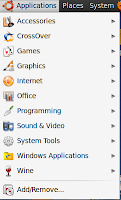
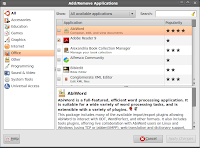
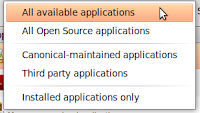
2. Select categories and select software or you can search software you want.
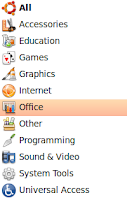


3. Click Apply and Ubuntu will ask password, insert password and click OK.
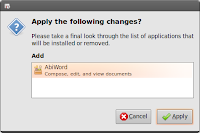

4. Wait for the package files to download and install. Click Close or Add/Remove More Applications after installation finished.
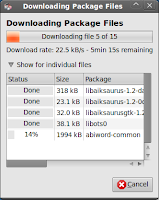

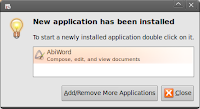
1. Select Add/Remove from Application menu and Add/Remove Application will appear. Select all available applications to show all applications available in your repositories.



2. Select categories and select software or you can search software you want.



3. Click Apply and Ubuntu will ask password, insert password and click OK.


4. Wait for the package files to download and install. Click Close or Add/Remove More Applications after installation finished.



Labels:
software installation in ubuntu,
tutorial,
ubuntu
Wednesday, August 12, 2009
Linux Advantages
Low cost: Linux is free, and open source, you don't have to pay it. You can download, burn , use it freely. You don't need spend time and money to obtain licence since Linux and much of its software come with the GNU General Public License. Once linux installed on your computer, you are freely to use open source softwares that included on your linux.
Stability: Linux is quite stable because it uses small resources. You don't need to have big memory and large hard disk to run your linux. It can be install on new and old computer. You also don't need defrag your hard disk periodically like windows operating system.
Choice: The large number of Linux distributions gives you a choice. Each distribution is developed and supported by a different organization. You can pick the one you like best; the core functionalities are the same; most software runs on most distributions.
Fast and easy installation.
Full use of hard disk: Linux continues work well even when the hard disk is almost full.
Multitasking: Linux is designed to do many things at the same time; e.g., a large printing job in the background won’t slow down your other work.
Security: Linux derive form UNIX, so it's not only free from virus, spyware and malware, but flexible file access permission systems prevent access by unwanted visitors or viruses.
Open Source: Most Linux applications are Open Source. You can download, use and share linux with your friends, family, school or business for absolutely nothing. You also free to modify linux source code and make new linux distro.
Stability: Linux is quite stable because it uses small resources. You don't need to have big memory and large hard disk to run your linux. It can be install on new and old computer. You also don't need defrag your hard disk periodically like windows operating system.
Choice: The large number of Linux distributions gives you a choice. Each distribution is developed and supported by a different organization. You can pick the one you like best; the core functionalities are the same; most software runs on most distributions.
Fast and easy installation.
Full use of hard disk: Linux continues work well even when the hard disk is almost full.
Multitasking: Linux is designed to do many things at the same time; e.g., a large printing job in the background won’t slow down your other work.
Security: Linux derive form UNIX, so it's not only free from virus, spyware and malware, but flexible file access permission systems prevent access by unwanted visitors or viruses.
Open Source: Most Linux applications are Open Source. You can download, use and share linux with your friends, family, school or business for absolutely nothing. You also free to modify linux source code and make new linux distro.
Installing Software on Ubuntu (Introduction) - Part 1
Software Installation on Ubuntu is quite different with Windows.. Actually it's not difficult to install software in Ubuntu. There are 4 basic ways:
1. Using Add/Remove Application

2. Using Synaptic Packages Manager

3. Using Terminal

4. Using DEB packages

To be Continue...
1. Using Add/Remove Application

2. Using Synaptic Packages Manager

3. Using Terminal

4. Using DEB packages

To be Continue...
Labels:
software installation in ubuntu,
tutorial,
ubuntu
What is Linux?
Linux is an operating system that was initially created as a hobby by a young student, Linus Torvalds, at the University of Helsinki in Finland. Linus had an interest in Minix, a small UNIX system, and decided to develop a system that exceeded the Minix standards. He began his work in 1991 when he released version 0.02 and worked steadily until 1994 when version 1.0 of the Linux Kernel was released. The kernel, at the heart of all Linux systems, is developed and released under the GNU General Public License and its source code is freely available to everyone. It is this kernel that forms the base around which a Linux operating system is developed. There are now literally hundreds of companies and organizations and an equal number of individuals that have released their own versions of operating systems based on the Linux kernel. More information on the kernel can be found at our sister site, LinuxHQ and at the official Linux Kernel Archives. The current full-featured version is 2.6 (released December 2003) and development continues.
Apart from the fact that it's freely distributed, Linux's functionality, adaptability and robustness, has made it the main alternative for proprietary Unix and Microsoft operating systems. IBM, Hewlett-Packard and other giants of the computing world have embraced Linux and support its ongoing development. Well into its second decade of existence, Linux has been adopted worldwide primarily as a server platform. Its use as a home and office desktop operating system is also on the rise. The operating system can also be incorporated directly into microchips in a process called "embedding" and is increasingly being used this way in appliances and devices.
Throughout most of the 1990's, tech pundits, largely unaware of Linux's potential, dismissed it as a computer hobbyist project, unsuitable for the general public's computing needs. Through the efforts of developers of desktop management systems such as KDE and GNOME, office suite project OpenOffice.org and the Mozilla web browser project, to name only a few, there are now a wide range of applications that run on Linux and it can be used by anyone regardless of his/her knowledge of computers. Those curious to see the capabilities of Linux can download a live CD version called Knoppix . It comes with everything you might need to carry out day-to-day tasks on the computer and it needs no installation. It will run from a CD in a computer capable of booting from the CD drive. Those choosing to continue using Linux can find a variety of versions or "distributions" of Linux that are easy to install, configure and use. Information on these products is available in our distribution section and can be found by selecting the mainstream/general public category. (Source: Linux Online (www. linux.org))
Apart from the fact that it's freely distributed, Linux's functionality, adaptability and robustness, has made it the main alternative for proprietary Unix and Microsoft operating systems. IBM, Hewlett-Packard and other giants of the computing world have embraced Linux and support its ongoing development. Well into its second decade of existence, Linux has been adopted worldwide primarily as a server platform. Its use as a home and office desktop operating system is also on the rise. The operating system can also be incorporated directly into microchips in a process called "embedding" and is increasingly being used this way in appliances and devices.
Throughout most of the 1990's, tech pundits, largely unaware of Linux's potential, dismissed it as a computer hobbyist project, unsuitable for the general public's computing needs. Through the efforts of developers of desktop management systems such as KDE and GNOME, office suite project OpenOffice.org and the Mozilla web browser project, to name only a few, there are now a wide range of applications that run on Linux and it can be used by anyone regardless of his/her knowledge of computers. Those curious to see the capabilities of Linux can download a live CD version called Knoppix . It comes with everything you might need to carry out day-to-day tasks on the computer and it needs no installation. It will run from a CD in a computer capable of booting from the CD drive. Those choosing to continue using Linux can find a variety of versions or "distributions" of Linux that are easy to install, configure and use. Information on these products is available in our distribution section and can be found by selecting the mainstream/general public category. (Source: Linux Online (www. linux.org))
What is Ubuntu?
Ubuntu is a complete operating system that is perfect for laptops, desktops and servers. Whether at home, school or work Ubuntu contains all the applications you'll ever need including word processor, email application and web browser. Ubuntu is and always will be free of charge. You do not pay any licensing fees. You can download, use and share Ubuntu with your friends, family, school or business for absolutely nothing. Once installed, your system is ready to use with a full set of productivity, internet, drawing and graphics applications, and games.
Wednesday, August 5, 2009
MAHIR LINUX?
MAHIR LINUX - tentu anda ingat saya ini mahir dalam linux.. tidak, saya bukan lah pakar dalam linux, tetapi tujuan MAHIR LINUX adalah untuk memahirkan diri saya dalam dunia linux, di samping dapat berkongsi dengan anda semua tentang dunia linux, tak kiralah anda mahir atau tidak mahir dalam linux. Saya berharap dengan blog ini, saya dapat pelajari ilmu linux dengan lebih gigih, kerana dengan cara menulis sahaja saya akan berusaha untuk maju dalam linux..namun begitu saya bukan lah buta sangat dalam linux. apa yang saya tahu, saya akan kongsikan kepada anda. Mungkin anda pun yang mahir atau pakar linux dapat sama-sama berkongsi ilmu linux dalam blog ini.
Saya tahu linux masih tidak digemari oleh kebanyakan rakyat negara ini, ada yang berkata linux ni susah nak pelajari, susah nak cari perisian sesuai untuk buat kerja, susah nak buat macam-macam perkara..saya faham masalah ini, dulu pun saya beranggapan begitu, tetapi sekarang tidak lagi, linux sudah menjadi sebahagian daripada hidup saya. Dengan linux saya dapat menghargai, dunia komuniti perisan terbuka (open source). Saya berharap suatu hari nanti saya akan menggunakan sepenuhnya linux dan perisian-perisian open source. Dan saya juga berharap saudara juga begitu..Linux tidak lah sesusah dahulu, kerana linux dan perisian-perisian sumber terbuka sekarang kian hari kian hebat. Malah kadang-kadang linux dan perisian sumber terbuka lebih hebat daripada perisian berbayar..
MAHIR LINUX bukan sahaja memfokuskan kepada Linux semata-mata, tetapi ia juga kepada perisian-perisan percuma dan perisian sumber terbuka yang boleh dipasang dalam linux. Ini kerana, tanpa perisian-perisian ini, linux tidak akan menjadi hebat. kedua-duanya saling memerlukan antara satu sama lain.. Insyallah saya akan cuba fokuskan kepada tutorial linux dan perisian sumber terbuka disamping dapat memberi info-info terkini mengenai dunia linux dan perisian open source.
Tentu saudara tertanya-tanya, distro apa yang saya pilih untuk MAHIR LINUX.. Saya sebenarnya fokus kepada UBUNTU LINUX. Alah, asik-asik UBUNTU, takda distro lain ke?? Maaf lah saudara-saudara semua, buat masa ini, saya lebih banyak pengetahuan mengenai UBUNTU. Ini kerana pc dan laptop saya hanya ada UBUNTU.. lagipun saya sudah biasa dengan UBUNTU. Mungkin suatu hari, saya berubah ke distro lain, boleh lah saya terangkan pasal distro tersebut.. Namun begitu kalau ada kesempatan, mungkin saya akan menulis pasal distro-distro lain seperti FEDORA, OPEN SUSE dan sebagainya. Mungkin anda yang mahir dalam distro lain, boleh sama- sama kongsi.. Bukan nya saya tak pernah cuba distro lain. Saya sudah kenal linux masa saya belajar kat USM lagi. Tahun Pertama (2000) lagi, pensyarah kat usm suruh buat programming dalam Linux. Masa tu USM pakai Redhat Linux... Malah projek tahun akhir pun saya guna Red Hat Linux 8. Tapi pada masa tu, saya tidak berminat sangat dengan Linux. Mungkin linux masa tu tidak sehebat sekarang.. Kini, banyak sudah berubah..Perisian-perisan open-source pun makin banyak dan kebanyakan dah matang dan stabil. Masa saya kerja dalam sektor kerajaan (hingga sekarang), saya juga didedahkan dengan SUSE LINUX.. Server-server kat tempat kerja saya banyak guna linux.. Ada jugak saya try install SUSE LINUX kat pc ofis saya, tapi tak sampai seminggu , saya guna windows balik.. mungkin SUSE bukan sesuai dengan saya..
OK sebab apa saya pilih UBUNTU. saya betul-betul kenal ubuntu pada April tahun 2009,. Dulu lagi saya tahu UBUNTU tu linux jugak.. tapi saya tak tertarik langsung.. lebih-lebih lagi bila dengar nama pun saya tak berkenan..Tapi entah macam mana tah, tiba-tiba saya terasa ingin install ubuntu kat PC saya.. lagi pun UBUNTU ada WUBI, iaitu boleh install ubuntu dalam Windows... masa tu UBUNTU HARDY HERON (8.04). Lepas saya install, saya tak berkenan lagi, lebih-lebih lagi tengok warna wallpaper ubuntu yang memang tak lawa langsung... tapi apa yang menyebabkan saya suka UBUNTU ialah, ubuntu dapat detect printer ofis saya dengan mudah sekali, tanpa perlu cari driver.. Selain itu, banyak blogger-blogger negara ni memilih ubuntu sebagai distro mereka, jadi rujukan mengenai UBUNTU mudah untuk dicari.. Komuniti UBUNTU juga memang sangat baik.. bila ada masalah saya akan tanya komuniti ubuntu, mereka dengan pantas menjawab soalan-soalan saya tu.. huhu.. tu je lah untuk hari ini.. sori.. banyak berleter pulak... bye bye..
Saya tahu linux masih tidak digemari oleh kebanyakan rakyat negara ini, ada yang berkata linux ni susah nak pelajari, susah nak cari perisian sesuai untuk buat kerja, susah nak buat macam-macam perkara..saya faham masalah ini, dulu pun saya beranggapan begitu, tetapi sekarang tidak lagi, linux sudah menjadi sebahagian daripada hidup saya. Dengan linux saya dapat menghargai, dunia komuniti perisan terbuka (open source). Saya berharap suatu hari nanti saya akan menggunakan sepenuhnya linux dan perisian-perisian open source. Dan saya juga berharap saudara juga begitu..Linux tidak lah sesusah dahulu, kerana linux dan perisian-perisian sumber terbuka sekarang kian hari kian hebat. Malah kadang-kadang linux dan perisian sumber terbuka lebih hebat daripada perisian berbayar..
MAHIR LINUX bukan sahaja memfokuskan kepada Linux semata-mata, tetapi ia juga kepada perisian-perisan percuma dan perisian sumber terbuka yang boleh dipasang dalam linux. Ini kerana, tanpa perisian-perisian ini, linux tidak akan menjadi hebat. kedua-duanya saling memerlukan antara satu sama lain.. Insyallah saya akan cuba fokuskan kepada tutorial linux dan perisian sumber terbuka disamping dapat memberi info-info terkini mengenai dunia linux dan perisian open source.
Tentu saudara tertanya-tanya, distro apa yang saya pilih untuk MAHIR LINUX.. Saya sebenarnya fokus kepada UBUNTU LINUX. Alah, asik-asik UBUNTU, takda distro lain ke?? Maaf lah saudara-saudara semua, buat masa ini, saya lebih banyak pengetahuan mengenai UBUNTU. Ini kerana pc dan laptop saya hanya ada UBUNTU.. lagipun saya sudah biasa dengan UBUNTU. Mungkin suatu hari, saya berubah ke distro lain, boleh lah saya terangkan pasal distro tersebut.. Namun begitu kalau ada kesempatan, mungkin saya akan menulis pasal distro-distro lain seperti FEDORA, OPEN SUSE dan sebagainya. Mungkin anda yang mahir dalam distro lain, boleh sama- sama kongsi.. Bukan nya saya tak pernah cuba distro lain. Saya sudah kenal linux masa saya belajar kat USM lagi. Tahun Pertama (2000) lagi, pensyarah kat usm suruh buat programming dalam Linux. Masa tu USM pakai Redhat Linux... Malah projek tahun akhir pun saya guna Red Hat Linux 8. Tapi pada masa tu, saya tidak berminat sangat dengan Linux. Mungkin linux masa tu tidak sehebat sekarang.. Kini, banyak sudah berubah..Perisian-perisan open-source pun makin banyak dan kebanyakan dah matang dan stabil. Masa saya kerja dalam sektor kerajaan (hingga sekarang), saya juga didedahkan dengan SUSE LINUX.. Server-server kat tempat kerja saya banyak guna linux.. Ada jugak saya try install SUSE LINUX kat pc ofis saya, tapi tak sampai seminggu , saya guna windows balik.. mungkin SUSE bukan sesuai dengan saya..
OK sebab apa saya pilih UBUNTU. saya betul-betul kenal ubuntu pada April tahun 2009,. Dulu lagi saya tahu UBUNTU tu linux jugak.. tapi saya tak tertarik langsung.. lebih-lebih lagi bila dengar nama pun saya tak berkenan..Tapi entah macam mana tah, tiba-tiba saya terasa ingin install ubuntu kat PC saya.. lagi pun UBUNTU ada WUBI, iaitu boleh install ubuntu dalam Windows... masa tu UBUNTU HARDY HERON (8.04). Lepas saya install, saya tak berkenan lagi, lebih-lebih lagi tengok warna wallpaper ubuntu yang memang tak lawa langsung... tapi apa yang menyebabkan saya suka UBUNTU ialah, ubuntu dapat detect printer ofis saya dengan mudah sekali, tanpa perlu cari driver.. Selain itu, banyak blogger-blogger negara ni memilih ubuntu sebagai distro mereka, jadi rujukan mengenai UBUNTU mudah untuk dicari.. Komuniti UBUNTU juga memang sangat baik.. bila ada masalah saya akan tanya komuniti ubuntu, mereka dengan pantas menjawab soalan-soalan saya tu.. huhu.. tu je lah untuk hari ini.. sori.. banyak berleter pulak... bye bye..

